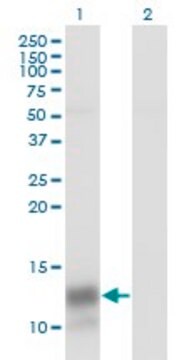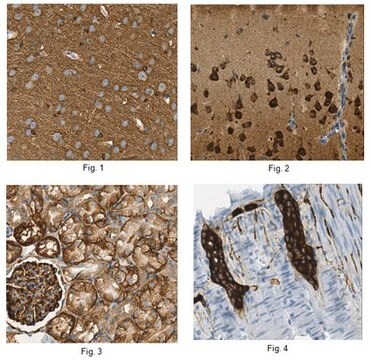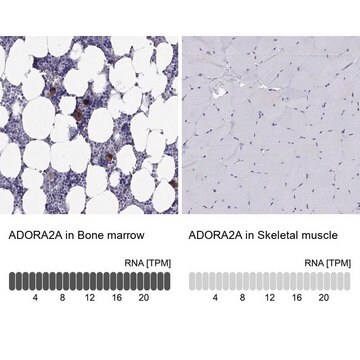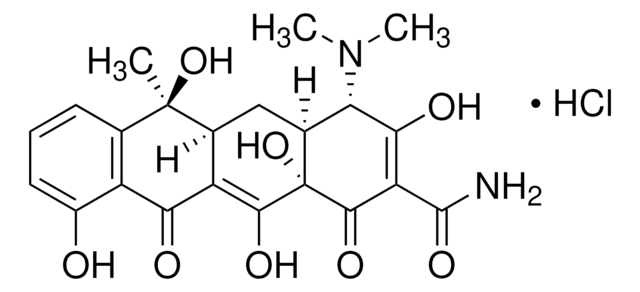MABS1255
Anti-Platelet Factor 4 Antibody, clone 197.2
clone 197.2, from mouse
Synonym(e):
Platelet factor 4, C-X-C motif chemokine 4, Iroplact, Oncostatin-A, PF-4
About This Item
Empfohlene Produkte
Biologische Quelle
mouse
Qualitätsniveau
Antikörperform
purified immunoglobulin
Antikörper-Produkttyp
primary antibodies
Klon
197.2, monoclonal
Speziesreaktivität
human
Methode(n)
ELISA: suitable
flow cytometry: suitable
immunocytochemistry: suitable
western blot: suitable
Isotyp
IgG1κ
NCBI-Hinterlegungsnummer
UniProt-Hinterlegungsnummer
Versandbedingung
ambient
Posttranslationale Modifikation Target
unmodified
Angaben zum Gen
human ... PF4(5196)
Verwandte Kategorien
Allgemeine Beschreibung
Spezifität
Immunogen
Anwendung
ELISA Analysis: A representative lot detected PF4 in the absence of heparin by ELISA. Decreased immunoreactivity of clone 197.2 was seen toward heparin-complexed PF4 (Xiao, Z., et al. (2008). Blood. 112(4):1091-1100).
Function Analysis: A representative lot and PF4, but not clone 197.2 or PF4 alone, activated human neutrophils as indicated by Mac-1 upregulation (Xiao, Z., et al. (2008). Blood. 112(4):1091-1100).
Immunocytochemistry Analysis: A representative lot, preconjugated with Alexa Fluor™ 488, immunolabeled the co-administered PF4 on human neutrophils. CD32a (Fc gamma RIIA) was seen co-localized with the PF4 anti-PF4 immune complexes on the surface of activated neutrophils (Xiao, Z., et al. (2008). Blood. 112(4):1091-1100).
Western Blotting Analysis: A representative lot detected PF4 under both reduced and non-reduced condition by recognizing a linear epitope (Xiao, Z., et al. (2008). Blood. 112(4):1091-1100).
Qualität
Flow Cytometry Analysis: 1 µg of this antibody detected PF4 in one million 4% paraformaldehyde-fixed, 0.2% Triton X-100-permeabilized human platelets.
Zielbeschreibung
Physikalische Form
Sonstige Hinweise
Rechtliche Hinweise
Sie haben nicht das passende Produkt gefunden?
Probieren Sie unser Produkt-Auswahlhilfe. aus.
Lagerklassenschlüssel
12 - Non Combustible Liquids
WGK
WGK 2
Flammpunkt (°F)
Not applicable
Flammpunkt (°C)
Not applicable
Analysenzertifikate (COA)
Suchen Sie nach Analysenzertifikate (COA), indem Sie die Lot-/Chargennummer des Produkts eingeben. Lot- und Chargennummern sind auf dem Produktetikett hinter den Wörtern ‘Lot’ oder ‘Batch’ (Lot oder Charge) zu finden.
Besitzen Sie dieses Produkt bereits?
In der Dokumentenbibliothek finden Sie die Dokumentation zu den Produkten, die Sie kürzlich erworben haben.
Unser Team von Wissenschaftlern verfügt über Erfahrung in allen Forschungsbereichen einschließlich Life Science, Materialwissenschaften, chemischer Synthese, Chromatographie, Analytik und vielen mehr..
Setzen Sie sich mit dem technischen Dienst in Verbindung.







